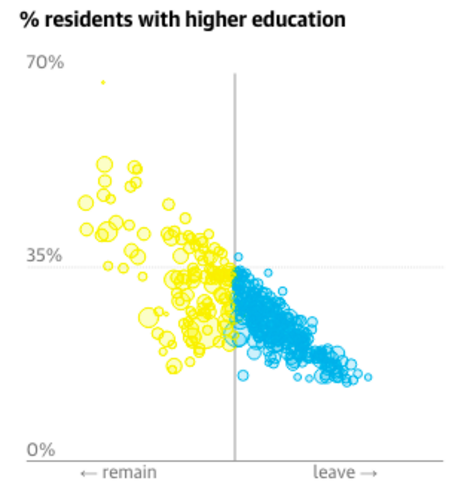Last week’s big news was Britain’s decision, via referendum, to leave the European Union. The results of the vote lead Prime Minister Cameron to resign and sent markets reeling, and it’s still unclear what the ultimate economic and political effects will be. For some keen, if depressing, insight on the ramifications of Brexit, you may want to read this essay by Fusion’s Felix Salmon.
Analyses of the vote in Britain point up the sharp generational, educational and geographic cleavages that produced the outcome. Older and less well-educated voters favored leaving, younger and more highly-educated voters preferred to remain the the European Union. As the BBC reported, those 18 to 24 voted almost 3 to 1 in favor of remaining; a majority of those over 45 voted to leave:

There was a strong correlation between the education level of an area, and its vote on the referendum. According to data analyzed by The Guardian, the highest educated areas voted most strongly to remain; the least well-educated areas tended to vote to leave.

And similar to our own red state/blue state divisions—a topic we’ve explored at City Observatory—there’s a strong geographic split in the vote in the UK, especially in England. (All of Scotland and most of Northern Ireland favored staying in the EU, by sizable margins.) As Emily Badger has pointed out in the Washington Post, there’s an urban/rural divide in the election returns. London and its environs, and Liverpool and Manchester supported remaining by substantial margins. The more rural parts of England voted to leave. The Washington Post’s map casts the vote in familiar red/blue hues, with the remain vote shown as blue and the leave vote shown as red.

Another way to look at this question is to consider the relationship between population density and voting patterns. Studies of the US showed a strong correlation: higher density counties were much more likely to vote for Barack Obama than Mitt Romney in 2012. To dig deeper into this question, we gathered data on the population density of English electoral districts and compared it to the fraction of local electors voting to remain in the European Union. Density data are the number of eligible electors (voters) in each of England’s 380 electoral districts, divided by the number of hectares in the district (electors per hectare). These data come from the Local Government Boundary Commission. We obtained election returns for each district from the UK Electoral Commission.
This chart shows the relationship between each electoral district’s density (shown on the horizontal axis, densest areas to the right of the chart) with the fraction of the voters favoring remaining in the European Union (vertical axis, higher values corresponding to a greater percentage of voters favoring remaining). Since there are varying numbers of voters in each district, we’ve displayed these results as a bubble chart, with the size of each bubble corresponding to the number of votes cast in each electoral district.
In general, the denser an electoral district, the more likely it was to was to vote to remain in the EU. All of the electoral districts with densities of 40 or more electors per hectare voted to remain. The pattern for lower density districts was more diffuse, but on average those with the lowest levels of density cast their ballots for leaving.
The geographic, demographic and generational polarization around issues like Brexit may be a sign of our times. In a world still being reshaped by globalization and technological change—and still working to cope, fitfully, with the aftermath of the worst economic downturn in eight decades, there’s a division between those who greet the future with optimism and those who are looking to return, or cling to, a seemingly fast disappearing past. Many of the fault lines are defined by place, with many city economies drawing and attracting talent, flourishing with the growth of global connectedness. But others, especially in smaller towns and rural areas haven’t gained so much from change. As Britain’s Brexit election shows us, the divisions are deep. Addressing them will be a major issue for all of us.